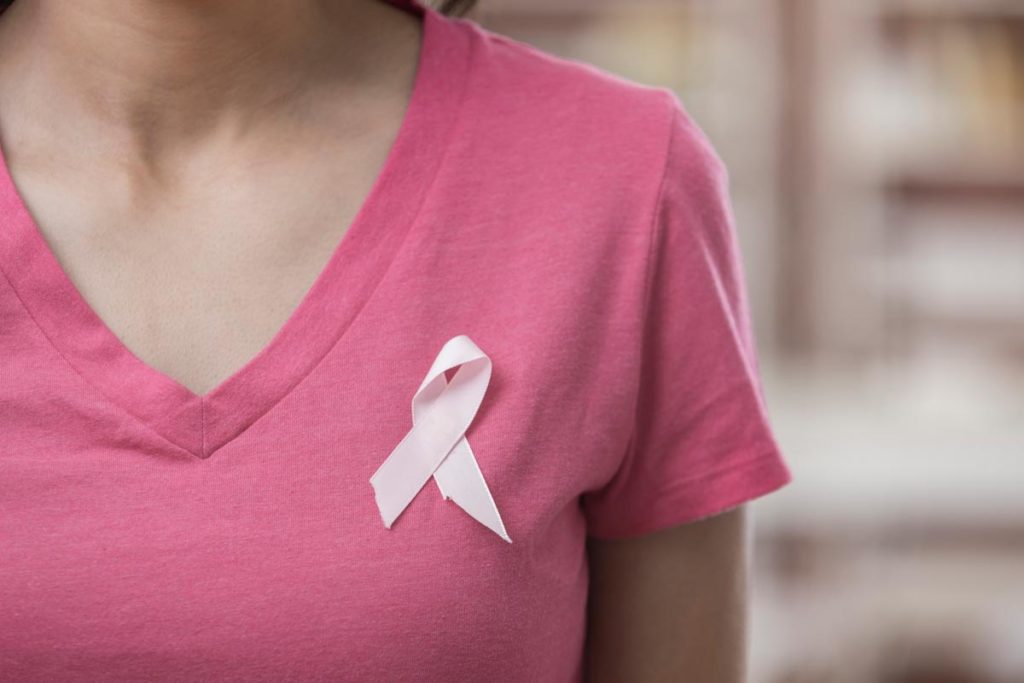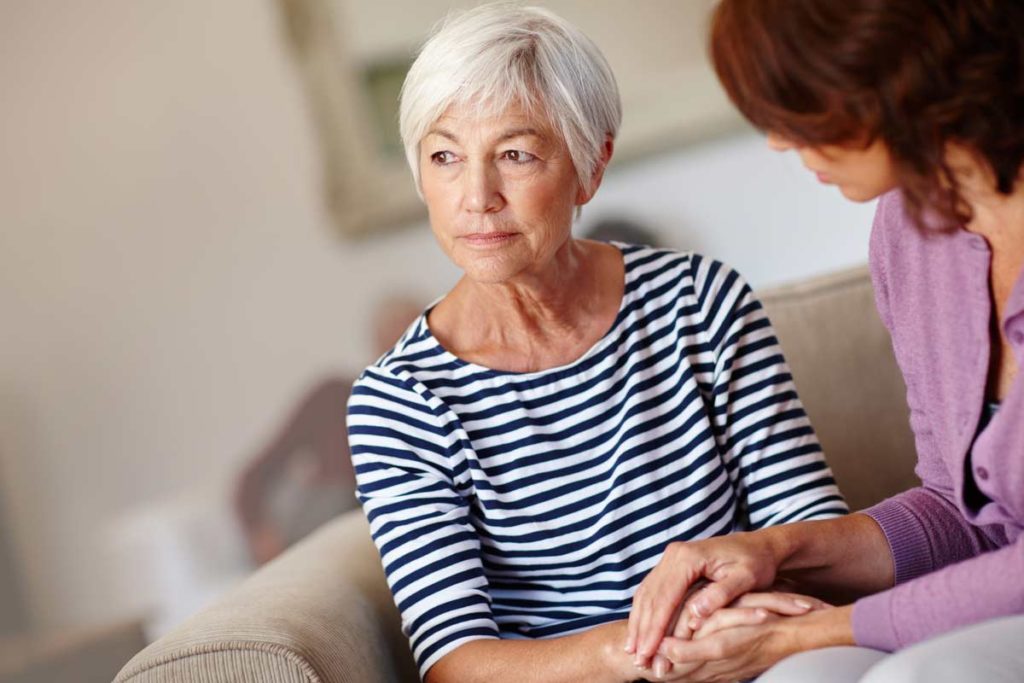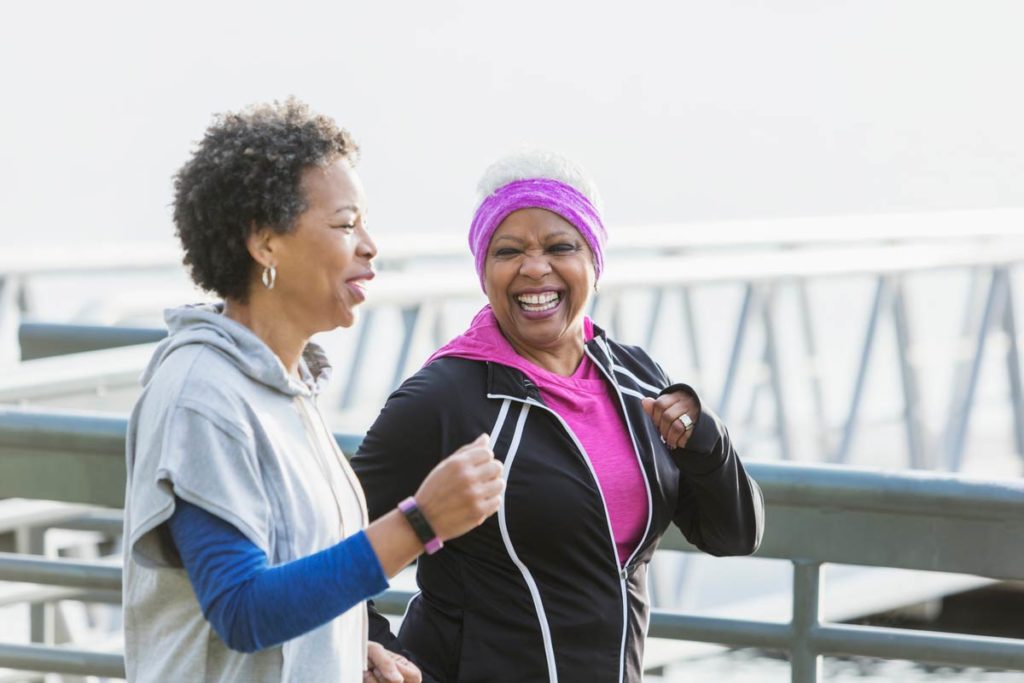Additionally, of the 48 million seniors living in America in 2016, about 55 percent of them (or 27 million) were women. Women also have a higher life expectancy (81 years) than men (76 years) in the U.S., which means a higher chance of developing health issues simply for the fact that they, generally, live longer than men do and their bodies have more time to develop diseases.
In this guide, we’ll discuss the top seven health conditions affecting elderly women, what their causes, symptoms, and treatments are, and steps that can be taken for prevention. The following contents are not ranked by how frequently they occur, but rather they are a grouping of some of the most common health concerns faced by elderly women.
Breast Cancer
The American Cancer Society says there is a one-in-eight chance that a woman will develop breast cancer in her lifetime
Breast cancer is the most common form of cancer among women, and it is the leading cause of death among cancers for women, too. It accounts for about 30 percent of cancer among all women. The American Cancer Society says there is a one-in-eight chance that a woman will develop breast cancer in her lifetime, but the ACS is more hopeful than they are pessimistic, noting that also means there’s a seven-in-eight chance a woman won’t develop it.
In 2018 alone, more than 250,000 new cases of “invasive” breast cancer were diagnosed. “Invasive” breast cancer, as opposed to non-invasive, is defined as cancer that grows into the tissue of the breast as opposed to being located around the milk ducts of the breasts. Most forms of breast cancer are invasive, and more than half of breast cancer diagnoses happen among women aged 65 and over.
As a result of these massive diagnoses, the ACS predicts that more than 40,000 women will die from breast cancer in 2018. A recent study also revealed that women who are over 65 and diagnosed with breast cancer have a higher mortality rate than those under 65.
Because of its prevalence among elderly women, it’s vital to understand how to identify breast cancer, get screened for it, and treat it.

Signs And Symptoms
Identifying breast cancer at its earliest possible stage is vital, so you need to know the symptoms. The most common signs of breast cancer include:
A small lump on the breast
This is the most prominent and common sign of breast cancer. The lump may be extremely small, such as the size of a coin, or even bigger. The mass is typically not painful, but there may be tenderness around it. If there is a small lump present, have it checked by a healthcare professional immediately.
General swelling
The breast(s) may swell, with or without pain.
Inverted nipple
Your nipple may turn inward from its normal outward position.
Pain
You may feel general soreness or pain in one or both breasts.
Discharge
One or both breasts may discharge fluid (other than breast milk).
Collar bone swelling
The ACS notes that tissue near your shoulder and collarbone may begin to swell due to the presence of breast cancer before it starts to show.
Getting Screened
If you notice any of the aforementioned symptoms, you should get screened as soon as possible. The screening process for breast cancer is known as a mammogram. It is essentially an X-ray of the breast area and will help identify masses or tumors that haven’t shown on the surface yet.
Most breast cancer develops and is diagnosed in people over the age of 50, but doctors recommend that you receive yearly mammograms starting at 45—or sometimes even before.
You are equally as important in the screening process as your doctor is, though. Typically these mammograms takes place once a year, so there is plenty of time between doctors visits for cancers to develop and appear on your breasts. It’s important to know how your breasts typically feel, in addition to the symptoms and signs of breast cancer to know if something is off.
Treatment
There is a range of treatment options for breast cancer depending on its invasiveness and its stage. Let’s look at some of the main treatment options:
Surgery
This is the most common option for breast cancer that is still localized in the breast. There are two main forms of breast cancer surgery: breast-conserving surgery, which aims to keep the part of the non-affected breast untouched; and a mastectomy, which is the complete removal of the breast. Which surgery you get depends on how much the cancer has spread.
Radiation
If the cancer is still localized in the breast, radiation therapy—which targets a very specific grouping of cells—is a prefered option. It’s relatively non-invasive, and it may be used after surgery to help reduce the risk of cancer reappearing.
Chemotherapy
Used both before and after surgery, chemotherapy aims to rid the body of the cancer if it has spread beyond the breast. Pre-surgery, the ACS points out, chemotherapy is used to try and reduce the size of the tumor so it’s easier to take out during surgery. Chemo is used after surgery to help clear up any cancer cells that may still be present.
Osteoporosis
It’s recommended that you request a bone density test from your doctor every year starting around age 50 to keep track of your bone density levels.

Osteoporosis is a condition that can occur when the body doesn’t produce enough bone to replace bone that you lose, which leads to weak, brittle bones that are prone to breaking easily.
Rather than having bones with a strong-binding structure, osteoporotic bones have a honeycomb-like structure with low density, which causes an easy break. The National Osteoporosis Foundation notes that the bones most likely to break when you have osteoporosis are the hips, wrist, and spine.
Osteoporosis greatly affects women over 50. There are about 10 million people in the U.S. who have osteoporosis, and more than 75 percent of them are women. The International Osteoporosis Foundation says that one-in-three women over 50 will suffer a fractured bone due to osteoporosis. The frequency is high with men, too, at one-in-five. The IOF also notes that osteoporosis causes nearly nine million breaks per year, which is about one every three seconds.
Causes
As mentioned before, osteoporosis forms when you are losing more bone than your body is capable of replacing. Over your lifetime, your body constantly replaces old bone with new bone, which is a process called resorption.
But as you age, your body can’t keep up with replacing bone that you’ve lost, which lowers overall bone density levels. Women also have smaller bones than men to begin with, which makes losing bone at a quick rate that much more critical.
There are external factors that assist your body in not producing as much bone anymore. These can include:
- Cancer
- Medications, like steroids and proton pump inhibitors
- Autoimmune diseases, like lupus and rheumatoid arthritis
- Poor dieting (low calcium intake)
Signs And Symptoms
Some warning signs and risk factors of osteoporosis include:
- Brittle bones (bones that break easily, like after a small bump or fall)
- Loss in height
- Slouchy posture
- Family history of osteoporosis
- Smaller frame
You may not notice you’re suffering from osteoporosis until the disease has fully onset. It’s recommended that you request a bone density test from your doctor every year starting around age 50 to keep track of your bone density levels.
The main way of getting tested for osteoporosis is through a bone mineral density test, which is done through a dual-energy X-ray absorptiometry (commonly called a DXA). It’s a painless process that takes about 15 minutes and measures your bone density to provide a value. That value is then compared to the value of other tests of people with healthy bone densities. Any value below 2.5 standard deviations below the normal is considered osteoporotic levels.
Treatment And Prevention
There are lifestyle choices you can make—both physically and with your diet—that can help try and prevent osteoporosis. The following are merely suggestions and not guarantees to help avoid bone degradation in your body:

Exercise
Lift weights and lose weight.
Medication
Various medications can combat the root cause of the disease, like a calcium deficiency or lack of hormones (from menopause)
Diet
Eat more foods rich in protein and calcium
Alcohol
Reduce your alcohol intake
Diabetes
A 2017 survey revealed that almost one-third of seniors have no emergency savings and 70 percent have less than six months of savings
Diabetes is one of the biggest health concerns among seniors. About 30 million Americans have some form of diabetes, and another 80 million have prediabetes, a condition that recognizes you’re nearing developing full-on diabetes. By the year 2050, it’s predicted that about one-in-three Americans will have diabetes.
Of the population that suffers from the condition, about 25 percent (around 12 million) are seniors, despite only being about 13 percent of the overall population. Diabetes diagnoses are split about evenly between men and women.
Diabetes is a condition that affects the body’s ability to process sugar and convert it to energy. If your body can’t process sugar, it causes high blood glucose levels, which can lead to a slew of health concerns like obesity, cardiovascular disease, kidney damage, and nerve damage.
There are two kinds of diabetes:
Type 1
This is a result of your pancreas not being able to produce insulin on its own. In this case, the body attacks the insulin-producing islets in the pancreas, rendering them useless. Type 1 diabetes is the least common of the two.
Type 2
This is the most common form of diabetes, as about 90 percent of people with diabetes have type 2. It develops over time when your blood sugar levels rise to levels that are too high. If you have too much sugar in your blood, your body can’t produce the necessary amount of insulin to bring to the cells and normalize blood sugar levels.
Warning signs for both forms of diabetes can be increased urination, extreme hunger, blurred vision, and fatigue.

Prevention
There are steps you can take to try and prevent type 2 diabetes. These include:
Losing weight
Obesity is directly tied to an increased likelihood that you’ll develop diabetes. The more overweight you are, the greater chance you have of developing diabetes, so it’s vital to lose weight to try and stay near proper levels. Weight loss goes hand-in-hand with other steps you can take.
Eating healthy
Type 2 diabetes is a direct result of having too much sugar in your body. Thus, it’s important to control how much sugar you put in your system. Avoid foods like sodas, candy, and fast food and replace them with foods with natural sugars, like fruits and vegetables. Eating healthier foods can help with losing weight, too. People with type 1 diabetes must control how much sugar they’re putting in their bodies as well.
Exercise
Lifting weights and performing cardiovascular activities can help with weight loss and heart health. Exercising doesn’t mean you need to join a gym and attend every day, though. Especially for seniors, exercising can come in the form of walking around the neighborhood a couple times a day or lifting small dumbbells.
Treatment
Right now, there is no cure for diabetes. Type 1 and type 2 are treated differently, because for one, your body can’t produce insulin at all, and for the other, your body can’t produce enough of it for how much sugar is in your body.
To treat type 1 diabetes, doctors will place you on an insulin pump or injections, both of which can provide your body with a healthy stream of insulin throughout the day. Type 2, on the other hand, is treated with medication (primarily Metformin) and the recommendations to increase exercise and eat healthier.
Arthritis
The CDC estimates that about 24 percent of all women suffer from arthritis, compared to about 18 percent of all men.
Arthritis is a term used to describe a disease that inflames joints, primarily in your knees, elbows, fingers, and ankles. More than 54 million Americans suffer from some form of arthritis, and more women have it than men. The CDC estimates that about 24 percent of all women suffer from arthritis, compared to about 18 percent of all men.
There are dozens of types of arthritis, but the most common among women include:
Osteoarthritis
This is the most common form of arthritis. It’s a form of degenerative arthritis, which means your joints degrade over time, causing bones to rub against each other. About 60 percent of people with arthritis have this form. Symptoms include pain and stiffness following inactivity, redness, swelling, and a decreased range of motion.
Rheumatoid arthritis
This is a form of arthritis where women “far outnumber” men who have it. It is an autoimmune disease, meaning that the body itself attacks joints and tissues, damaging them in the process. Symptoms are similar to osteoarthritis, but treating it is different because it’s rooted in repairing joints that have been damaged over a lifetime.
Gout
This disease deteriorates joints because of high levels of uric acid in the blood, which is typically broken down in the kidneys and excreted through urine. The high levels can cause pain, swelling, and tenderness in joints, typically starting in the big toe.
Treatment
One of the best treatments for arthritis is not losing your range of motion by staying active.

Treatment for arthritis begins with pain management, often because one of the best treatments for arthritis is not losing your range of motion by staying active and losing weight. Once joint pain is at a manageable level, you can begin to increase your exercise, like jogging and lifting weights, which can help ease the pressure and build up the muscles surrounding your joints.
Various medications are available to help with pain management, and they include pills and creams. Over-the-counter medications like aspirin and ibuprofen work fine if the pain isn’t overbearing.
Heart Disease
Heart disease is the leading cause of death of women in the U.S., and it’s the leading cause of death for men, too.
The American Heart Association notes that about 70 percent of women aged 60 to 79 suffer from a cardiovascular disease, and 87 percent of women over 80 have some form of CVD. These health issues can start before women adopt the “elderly” classification, too. One study noted that women aged 18 to 55 were more likely to suffer from a heart attack and a slew of other heart issues than men were.

Heart disease is a national epidemic caused by the narrowing or blocking of blood vessels all around your body. Heart disease is a general term used to describe different consequences of blocked arteries. These include:
Coronary artery disease (CAD)
The most common form of heart disease, CAD occurs when plaque builds up on the inner walls of arteries and other blood vessels.
Strokes
This is a cut off of blood flow to the brain, and a consequence of CAD.
Heart attacks
This occurs when the arteries leading to your heart are partially or completely blocked. It’s also a consequence of CAD. The Centers for Disease Control say that about 800,000 people have heart attacks or strokes every year, and about 75 percent of these people are having their first one.
Arrhythmias
This is an irregular heartbeat.
Heart failure
This happens when your heart can’t supply your body with the blood that it needs. This can cause a build up of fluid in your legs and feet, and also cause blood to go back up into your lungs.
Symptoms
While heart disease is an overarching term for many heart-related maladies, these diseases and consequences manifest themselves with similar symptoms because they’re all affecting the same muscle. These symptoms include:
- Chest pain or tightness, particularly on the left side near your heart
- Shortness of breath
- Lightheadedness
- A fluttering heartbeat (this particularly pertains to arrhythmias)
- Fainting
- Pain in the neck and jaw area
Strokes have a very specific set of symptoms that show on the surface. These symptoms can be remembered by the acronym FAST, according to the American Stroke Association. This stands for:
Face dropping: One side of your face may be numb, and it can be detected by trying to smile.
Arm weakness: An arm may be numb or sore. Try lifting both arms to see if you can control both.
Slurred speech: A stroke may show itself in your speech. Try to say a simple sentence like “I ran outside” without slurring any speech.
Time to call for help: If you or someone else is experiencing any or all of these, it’s time to call 9-1-1.
Treatment And Prevention
Having high blood pressure can also cause hypertension, which can result in heart attacks and strokes.
Heart disease and all the consequences that come with it can be prevented or treated, even after you’ve experienced a heart attack or stroke. While there are certain things that are out of your control that may make you prone to heart disease (age, gender, race), there are also many things in your control that can help prevent heart disease or bring your heart back to a healthy level. These include:
Blood pressure
High blood pressure is one of the leading causes of heart disease. Having high blood pressure can also cause hypertension, which can result in heart attacks and strokes.
Cholesterol
One in six Americans has high cholesterol (levels above 240 mg/DL), which is a major cause of heart disease.
Healthy diet
Obesity has a direct connection to developing heart disease. A diet consisting of too much sodium, fats, and cholesterol and not enough fruits and vegetables can escalate the risk of heart disease.
Exercise
Maintaining a healthy weight through exercise can help reduce the risk of heart disease.
Reduce smoking and drinking
Smoking and drinking can both increase blood pressure, especially if done in excess over time.

Dementia
Dementia is a broad term that describes any form of memory loss from disease, trauma, or otherwise. Some forms of dementia include:
Alzheimer’s disease
This is the most common form of dementia. About three-quarters of all dementia cases among the elderly are Alzheimer’s disease, which is a progressive ailment that gets worse over time. It’s highlighted by short-term memory, difficulty retaining information, general confusion, and difficulty paying attention.
Parkinson’s disease
In addition to memory loss, Parkinson’s leads to the deterioration of your motor functions.
Vascular dementia
This is memory loss caused by a stroke, which can also cause slurred speech and immobility.
Dementia with Lewy bodies
Similar to Alzheimer’s and Parkinson’s in terms of memory loss, but dementia with Lewy bodies can cause hallucinations.
Huntington’s disease
This disease is inherited and may begin to onset before 40 years old. It causes a deterioration of the brain, affecting cognitive and motor functions.
What causes dementia?
In most cases, a specific diagnosis of a form of dementia can’t be confirmed until an autopsy is performed on one’s brain after they pass. Generally, though, someone who suffered from dementia in their final years was found to have damaged brain cells and an excess build-up of protein on brain cells all over, which can prevent the cells from properly communicating with each other.
This is why dementia can impact all parts of life, and not just memory. Every part of the brain can be affected, starting with memory but then down to the parts of the brain that control the physical aspects of your life.
Treatment

Unfortunately, there is no cure for dementia. Once it onsets, treatment centers on trying to slow the progress of the cognitive and physical losses. Treatment also depends on the diagnosis and the reason the disease onset.
For instance, depression may have helped escalate cognitive issues, so doctors may want to first treat that and see how that affects the dementia’s progression. There are also medications that help boost memory, which may be prescribed in earlier stages.
Because there is no explicit way to prevent or treat dementia, there’s no harm in seeking out clinical trials and tests. Billions of dollars of research are going into try and figure out a cure.
Depression
Depression is a silent killer.
It can drive the elderly into isolation, which increases mortality rates due to the lack of social cognition and the dangers of aging alone. Depression can also feed the advancement of cognitive issues like Alzheimer’s disease and Parkinson’s disease. There are cases where doctors will treat depression to help slow the advancement of various forms of dementia. Depression also increases the risk of suicide.
This disease affects elderly women en masse. They are twice as likely to develop depression than men, though this statistic may be clouded by men not reporting their symptoms as much as women. Anywhere from 10-25 percent of women will suffer from depression in their life.
While it’s more frequent for a woman to suffer from depression when she’s younger, a study showed that anywhere from 1-5 percent of elderly people suffer from a major depressive disorder. These numbers increase to the double digits for elderly patients living in assisted living or home care.
Symptoms And Causes
Elderly women can go through a slew of trauma during their later life that can lead to depression. These events include:
- The loss of a partner or loved one
- Developing a chronic disease like dementia or heart disease
- Stressful life events like increased medical bills or hospital visits
- Decrease in social networks due to loss of friends or retirement
Despite the trauma an elderly woman may face over her life, depression is not a normal part of aging.
There is no one specific set of check marks to see if someone is depressed. Everyone’s situation is different, and a team of therapists and psychiatrists can help diagnose—and treat—depression. Some general questions you may want to ask yourself, thanks to the CDC, include:
- Do you have a feeling of hopelessness or worthlessness?
- Do you have thoughts of suicide?
- Do you feel generally fatigued and lack energy?
- Do you have difficulty focusing and completing tasks?
- Have you lost interest in activities that you once found enjoyable?
- Are you frequently waking up in the middle of the night or suffer from insomnia?
There are three kinds of depression, according to the National Institute of Mental Health:

Major depression
Those with major depressive disorder have their entire daily routine—from work, to sleep, to social interactions—disrupted. The episodes can last for years, and you can have multiple episodes.
Persistent depressive disorder
The symptoms of persistent depressive disorder aren’t as severe as major depressive disorder, but the symptoms last for years on end.
Minor depression
The symptoms are less severe than major depression and may only last for weeks or months. They can still last for years if left untreated, which can then develop into persistent depressive disorder. The majority of elderly people will suffer from minor bouts of depression than they will major depression, but it still needs to be treated.
Treatment
Depression can be treated by a team of therapists and psychiatrists, who can prescribe medications to treat the disease and help you get to the root of your depression. It’s never too late to seek help. Talk to your doctor about your symptoms and how you’re feeling, and he or she can lead you in the right direction.
Do you want to cite this page? Use our ready-made cite template.
